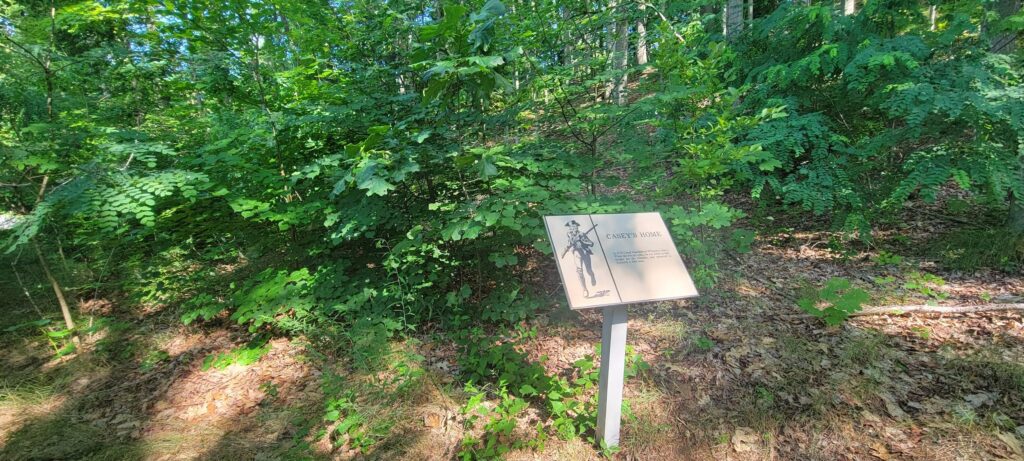Making a Case for Case
Written By: Julia Williams
Tucked away to the side of the historic Wayside and after a little trek through the woods, visitors look in the right direction, they may stumble upon a small plaque entitled “Casey’s Home”. The plaque reads: “In 1775 Casy was Samuel Whitney’s slave. When revolution came he ran away to war, fought for the colonies, and returned to Concord a free man.” For the last 50 years, these 2 sentences have been the only information available to visitors about a non-White person with connections to park land and the plaque isn’t even marked on a map.

“Casey’s Home” plaque
Historic homes hold the stories of so many unique experiences and at Minute Man, those stories include the likes of the Alcotts and the Hawthores. At different times, they both resided in the same house, The Wayside – a striking, three story home full of color. But before it was their house, it was the home of Samuel Whitney, his wife, and their thirteen children. Whitney was there for the first battle of the Revolutionary War as the muster master of Concord and he has been written into history forever for contributing to such an important battle. However, it’s not the history of the Alcotts or Hawthores, the Whitneys or the Revolution that needs more focus from the park – it’s one of the two people enslaved by the Whitneys. For the remainder of this post, Case, also known as Casey Whitney, will be the focus. Case and his story have been cast aside far to be pushed aside again.
Case was a formerly enslaved man living in Concord, MA. Kidnapped in West Africa and stolen from his home, his wife, and his 2 children at age 20, Case was brought to the Massachusetts Colony to be an enslaved man. It’s unknown who Case was enslaved to in his earlier life, but by 1771 he was enslaved by the muster master of Concord, Samuel Whitney. Case enlisted in the Revolutionary War in 1781 (traveling close to 20 miles to re-enlist after being rejected in Concord for being “too short”) and was freed following the war’s end. He eventually returned back to Concord and was recorded in the 1790 census simply as Case. For the next 32 years, Case survived by squatting in houses, living on the town poor farm, and being taken care of by his neighbors until his passing in 1822.

The Wayside, the home site where Case was enslaved to Samuel Whitney
For the past 50 years, this was the only “verified” information available on Case’s history. The only information visitors can receive about Case is from the 2 sentence plaque hidden away in the wood where they think he may have lived in one of the houses before the area got forested over. The only reason the park knew about Case’s history is because Henry David Thoreau mentioned him in a journal entry as a side character while recording the life stories of one Concord native. The excavation of “Casey’s Home” was only attempted because of the brief, unverified information in the journal. All documents and information found to be associated with Case was collected during this initial excavation and, despite one attempt in the 1980’s, has never been recontextualized or reexamined. Until now.
During our first week we reached out to a local historian and professor and he told us that all of “the available evidence about Casey Whitney has pretty much been consulted” and that our best bet was to comb through the Concord Town Archives going year by year, from 1771 to 1822. In the time we have started this project, we have been able to more accurately estimate the location of his previous house site, learn where he lived in Concord after leaving the house,what his connections to other enslaved folks in Concord may have looked like, and the strength of his relationships with some of the White individuals in town. Being discouraged by not finding relevant information through avenues that traditionally work for White historic figures is not helping lift these BIPOC stories to light. It wasn’t that Case’s history wasn’t available, it was that Case and his role in Concord wasn’t truly being considered when researching his history.

Julia Williams, CRDIP Archeological Resource Member and her project supervisor, Dr. Angela Cooper
Tasked with reinterpreting and reanalyzing the history of Case, it became clear pretty early on how little past researchers had done to look beyond the obvious. It can not be assumed that historic information was kept for members of non-White groups in the same way it was the White majority. The reality of this time period in American history is that non-White people were rarely thought of as anything other than being a part of someone else’s life story. With this history in mind, it’d be doing the park a disservice to research Case and expect his history to be available in the same way as Concord’s White residents. We have searched for Case in newspaper ads, archival oral histories, and in the private journals and self written family histories of White residents. We have taken trips to near-by historic homes in Concord and asked about their enslaved population, hoping it will lead us to a connection back to Case (which has worked in many cases). Through ACE, this experience has taught me that it is so easy to forget history if it’s not recorded, but for people like Case, their story is there if you’re willing to look.
